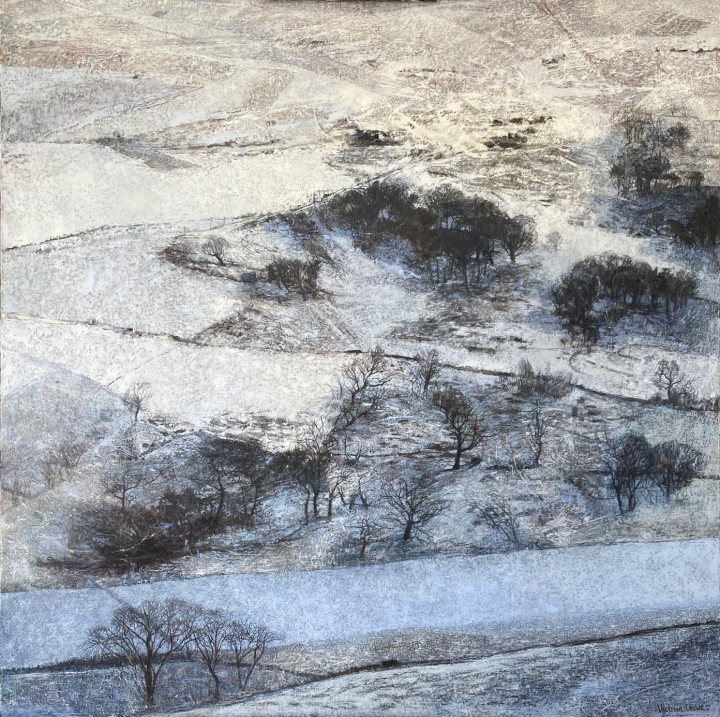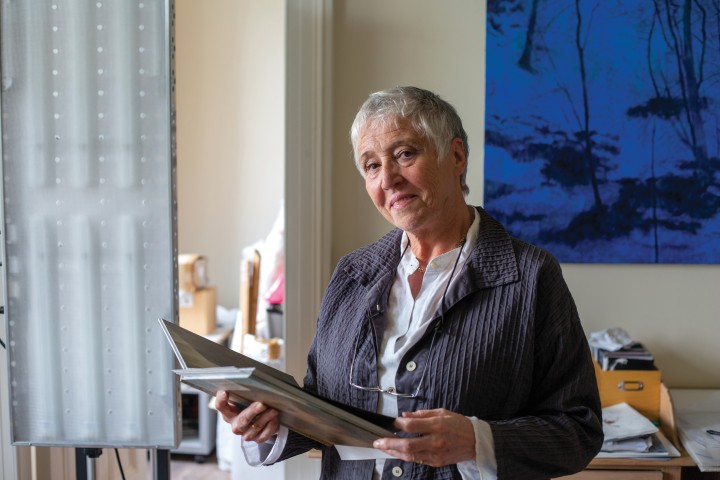Scottish Art News
Latest news
Magazine
News & Press
Publications
My Favourite Scottish Work of Art: Charlotte Rostek
By Charlotte Rostek, 05.05.2022

I have decided to look at my recent book Scottish Women Artists for a favourite painting: Victoria Crowe’s How the Snow Lay on the Hill, oil on linen, from 2021.
I absolutely adore Crowe’s earlier cycle of paintings, ‘A Shepherd’s Life’ and How the Snow Lay on the Hill connects me back to this work at the same time as it takes me beyond it. I love the quietude which emanates from the near-monochromatic colour range; I love the way the composition fills the whole canvas suggesting expansiveness and horizons that reach far beyond the square of the linen canvas. I love the fact that it is at once muted, almost stark, restrained and at the same time luminous (the patches where there seem to be thicker layers of snow).
There is also a light that comes from above in the top part of the painting, it doesn’t quite reach the snow laden river and I can feel the transition from the warm winter-rays on one’s face to the darker, cold embrace of those parts which are already in the shade. It brings back memories of wintery hill walks in Scotland.
There is a real interest in and a relationship with the individually observed elements which make up the landscape, the clusters of trees, the divisions between grassy fields, the traces of human activity and, of course, the different ways the snow lies on the hill! The power of perception, the time spent, the careful study which have gone into this painting create a perfect equilibrium between an almost photorealist effect and a deeply visceral quality.
I love the way the picture nearly slips into abstraction in the upper, emptier reaches of the painting and are replaced by light and less certainty – a change, an uplift, room for the imagination.
I have always found the unspectacular, spectacular, it speaks to my own sense of appreciating small things and the restrained aesthetic makes you do exactly that, look for things of interest and beauty in an apparently bleak landscape. I feel connected.
Perhaps it’s the native German in me who naturally latches on to the romanticism of Scotland’s often stark and empty landscapes. Unlike, Crowe’s well known Large Tree Group from the 1970s, there is no visible human being in this vast countryside, but it is I, the viewer, who becomes this person, at once ‘earthed’ by the astutely observed landscape and spiritually uplifted.
 Victoria Crowe. Image by Kenneth Gray.
Victoria Crowe. Image by Kenneth Gray.
Victoria Crowe (b. 1945)
Born in Kingston upon Thames, Crowe was educated at Kingston School of Art and the Royal College of Art. At the age of 23 she began teaching at Edinburgh College of Art, where she remained for 30 years while developing her own practice. Alongside extensive exhibitions and fellowships, Crowe has taken on notable public portrait commissions including Nobel physicist Peter Higgs, composer Thea Musgrave and astrophysicist Dame Jocelyn Bell. In 2018 the Scottish National Portrait Gallery held 'Beyond Likeness', a retrospective exhibition of Crowe's portraits, and in 2019, the City Art Centre in Edinburgh hosted a lifetime retrospective, 'Fifty Years of Painting'.
Crowe is widely known for her winter landscapes in which observations of everyday experience are transformed into the strikingly unfamiliar through symbolic associations with dream and memory. Her works are frequently described as having a strong spiritual quality, evoking transcendent experiences witnessed through landscape. Crowe was awarded an OBE for Services to Art in 2004. In 2009, she received an Honorary Degree from The University of Aberdeen and, in 2010, was elected a Fellow of the Royal Society of Edinburgh. Her work is held in collections including the National Portrait Gallery, London; National Museums of Scotland; Scottish National Portrait Gallery; Scottish National Gallery of Modern Art; Danish 20th Century Portrait Collection, Frederiksborg Castle; Chatsworth House; and the Royal Academy.
How the Snow Lay on the Hill can be viewed currently at Flowers Gallery, London, as part of her exhibition 'Resonance of Time', running until 21st May. Crowe's own favourite Scottish work of art can be read here.
 ed.jpg) Charlotte Rostek.
Charlotte Rostek.
Charlotte Rostek
Charlotte Rostek is an arts and heritage professional based in Scotland currently working as Project Consultant for the historic Dalkeith Palace in Midlothian owned by the Buccleuch Living Heritage Trust. Charlotte was born in Germany and travelled widely before moving permanently from a post at the Kunsthalle Bielefeld to Scotland. She has held positions including Director of Collections at the Mount Stuart Trust, Isle of Bute; Curator to the Great Steward of Scotland’s Dumfries House Trust, Ayrshire, now the Prince’s Foundation; Curator for the National Trust for Scotland at Charles Rennie Mackintosh’s Hill House, Helensburgh; and Keeper of Art at Paisley Museum. As Curator at Dumfries House she worked on the restoration of the stately home and its important 18th century contents. She played a key role in transforming the house from a forgotten secret to one of Scotland’s finest visitor destinations, an important educational resource and a stunning venue for royal and community events.
This year, Rostek has written the Fleming Collection's newest, triumphant publication, Scottish Women Artists. She has told the tale of formidable artists from 18th century pioneers to the 1880s breakthrough ‘Glasgow Girls’, to the (largely forgotten) early modernists, to icons such as Joan Eardley, Anne Redpath and Elizabeth Blackadder, who, despite the dominance of ‘male painters, critics, collectors, curators, hanging committees and teachers’, placed women artists at the heart of the story of Scottish art. Rostek concludes with the generation of Turner prize winners and Venice Biennale stars who now represent Scottish art internationally. It is available for purchase through the Scottish Gallery.
Rostek will be returning to Dumfries House next week for the Boswell Book Festival on 14th May, to discuss this new publication in art history alongside James Holloway, previous director of the Scottish National Portrait Gallery and recent author on his own art collection. Info and tickets can be found for live and online viewing here.




